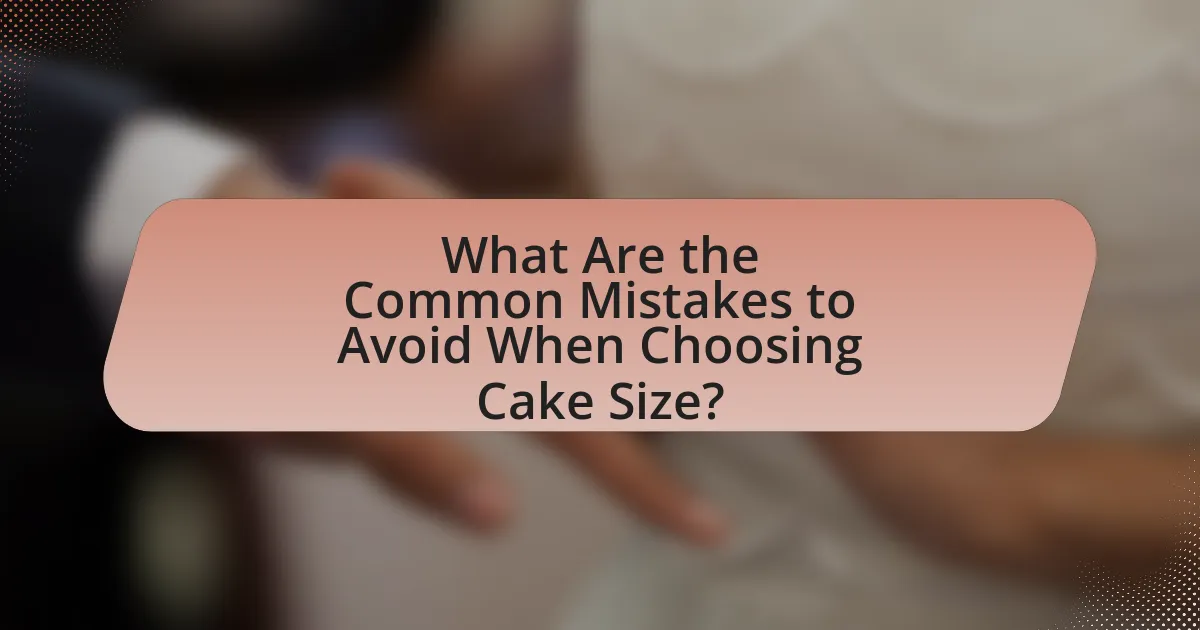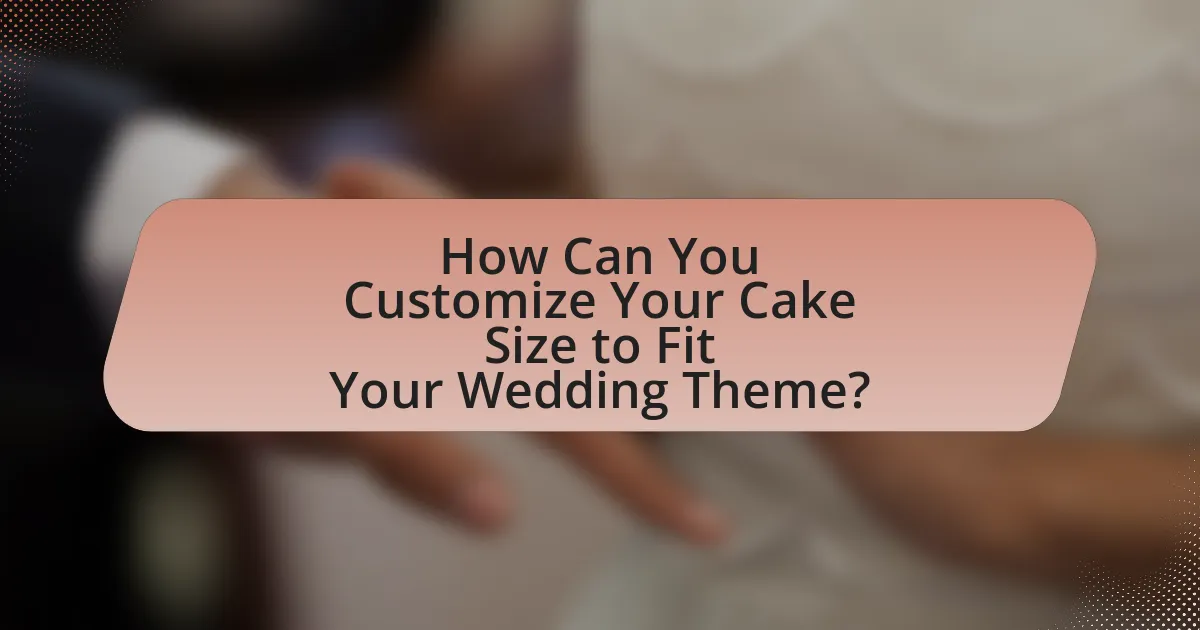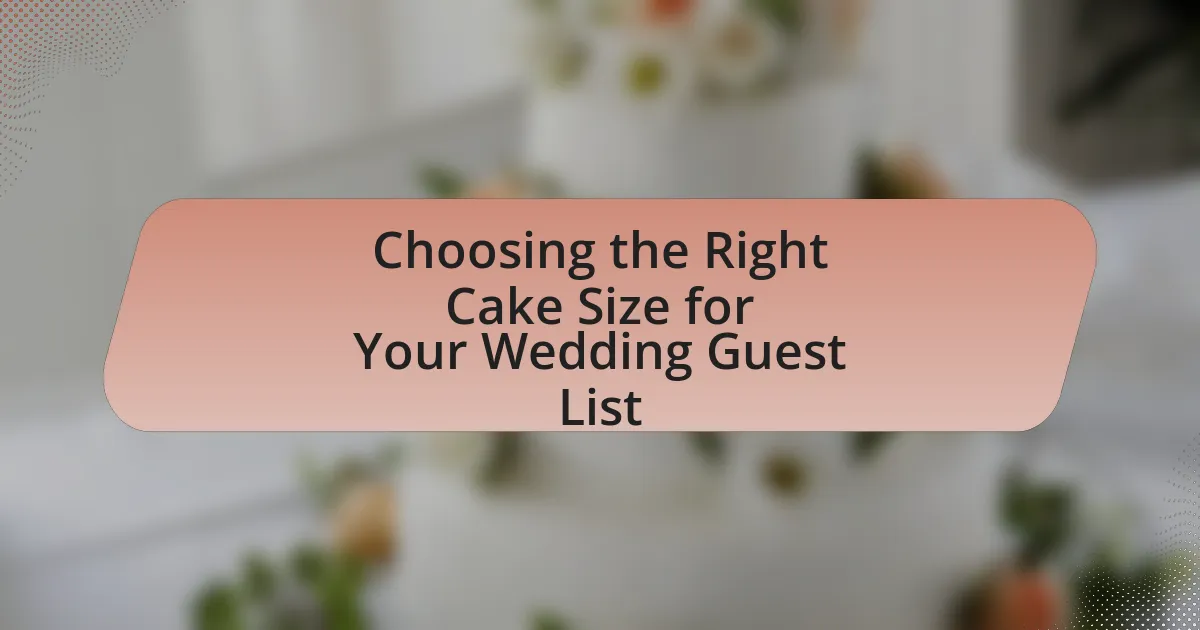Choosing the right cake size for your wedding guest list is crucial for ensuring that all attendees are satisfied. Key factors to consider include the number of guests, standard serving sizes, and the type of cake, as these elements directly influence the required cake dimensions. The article outlines methods for estimating guest counts, the impact of venue size on attendance, and common mistakes to avoid when planning cake quantities. Additionally, it discusses how to customize cake size to fit wedding themes, the importance of effective communication with bakers, and best practices for managing leftovers. By following these guidelines, couples can ensure their wedding cake meets both aesthetic and practical needs.

What Factors Should You Consider When Choosing Cake Size for Your Wedding Guest List?
When choosing cake size for your wedding guest list, consider the number of guests, serving size per person, and the type of cake. The number of guests directly influences the cake size needed; typically, one slice per guest is standard. A standard wedding cake slice is about 1 inch by 2 inches, which means a cake serving 100 guests should yield at least 100 slices. Additionally, if you plan to offer multiple dessert options or a larger slice size, adjust the cake size accordingly. For example, if you expect 150 guests but want to provide larger slices or additional desserts, you may need a cake that serves 200. These calculations ensure that all guests receive a slice, minimizing waste and ensuring satisfaction.
How do you determine the number of guests for your wedding?
To determine the number of guests for your wedding, start by creating a preliminary guest list that includes family, friends, and colleagues. This initial list helps establish a baseline number, which can be adjusted based on venue capacity and budget constraints. According to a survey by The Knot, the average wedding guest list consists of about 130 guests, but this can vary significantly based on personal preferences and cultural factors. By considering these elements, you can arrive at a more accurate estimate of your wedding guest count.
What methods can you use to estimate your guest count?
To estimate your guest count, you can use methods such as analyzing your RSVP responses, considering your venue capacity, and reviewing past event attendance. Analyzing RSVP responses provides a direct indication of who plans to attend, while considering venue capacity ensures that your guest list aligns with the space available. Additionally, reviewing past event attendance can offer insights into typical turnout rates, helping to refine your estimates. These methods are effective as they rely on concrete data and historical patterns, making them reliable for planning purposes.
How does your venue size influence guest count?
Venue size directly influences guest count by determining the maximum number of attendees that can comfortably fit within the space. A larger venue can accommodate more guests, allowing for a higher guest count, while a smaller venue limits attendance due to space constraints. For example, a venue with a capacity of 200 guests can host a larger wedding compared to a venue that only holds 50 guests. This relationship between venue size and guest count is crucial for event planning, as exceeding the venue’s capacity can lead to safety issues and discomfort for attendees.
What are the standard cake serving sizes?
The standard cake serving size is typically 1 slice per guest, which is approximately 2 inches by 2 inches for a square cake or 2 inches by 1 inch for a round cake. This serving size is commonly used for weddings and events, ensuring that each guest receives a manageable portion. For example, a standard wedding cake tier can serve about 12 to 15 guests when cut into these dimensions. This guideline helps in planning the appropriate cake size based on the number of guests, ensuring that there is enough cake for everyone without excessive leftovers.
How many servings does a typical wedding cake provide?
A typical wedding cake provides approximately 100 servings. This serving size is based on a standard three-tier cake, where each tier is designed to serve a specific number of guests. For example, a common configuration includes a bottom tier serving 50, a middle tier serving 30, and a top tier serving 20, totaling 100 servings. This estimation aligns with industry standards for wedding cakes, ensuring that most guest lists can be accommodated effectively.
What are the differences between serving sizes for different cake types?
Serving sizes for different cake types vary significantly based on their density and structure. For example, a standard slice of a light sponge cake typically measures about 1 inch by 2 inches, serving approximately 12 to 16 people per tier, while a denser cake like a fruitcake may yield smaller slices, serving around 8 to 10 people per tier due to its richness. Additionally, layered cakes often provide more servings than single-layer cakes; a three-tiered cake can serve 50 to 100 guests depending on the size of each tier. These differences are crucial for accurately planning cake quantities for events, ensuring that the number of servings aligns with the guest list.
How does cake tiering affect the overall size?
Cake tiering increases the overall size of a cake by adding multiple layers, each contributing to the total height and volume. Each tier typically consists of a separate cake layer, which can vary in diameter and height, allowing for a larger serving capacity. For example, a three-tier cake can provide significantly more servings than a single-layer cake of the same diameter, as the combined volume of the tiers creates a larger cake overall. This tiered structure not only enhances the visual appeal but also accommodates a greater number of guests, making it a practical choice for events with larger guest lists.
What are the benefits of multi-tiered cakes?
Multi-tiered cakes offer several benefits, primarily their ability to serve a larger number of guests while maintaining an elegant presentation. These cakes can be designed to accommodate various flavors and styles, allowing for customization that caters to diverse tastes among wedding attendees. Additionally, multi-tiered cakes create a visually stunning centerpiece that enhances the overall aesthetic of the wedding, contributing to memorable photographs and a festive atmosphere. The structural design of these cakes also allows for intricate decorations, which can reflect the couple’s theme or personal style, making the cake not just a dessert but a significant part of the wedding decor.
How do you calculate servings based on cake tiers?
To calculate servings based on cake tiers, first determine the size of each tier and the number of servings each can provide. Standard serving sizes for wedding cakes are typically 1 inch by 2 inches for a slice. For example, a 6-inch round cake tier serves about 12 people, an 8-inch tier serves approximately 24, and a 10-inch tier serves around 38.
To find the total servings, add the servings from each tier together. For instance, a three-tier cake with a 6-inch, 8-inch, and 10-inch tier would yield 12 + 24 + 38, totaling 74 servings. This method ensures that you accurately account for the number of guests when planning your cake size.

What Are the Common Mistakes to Avoid When Choosing Cake Size?
Common mistakes to avoid when choosing cake size include underestimating guest count, neglecting portion sizes, and failing to account for cake tiers. Underestimating guest count can lead to insufficient servings, resulting in guests not receiving cake. Neglecting portion sizes may cause confusion about how much cake each guest will actually consume; typically, a standard serving is about 1 to 2 inches. Additionally, failing to account for cake tiers can affect the overall presentation and serving; a multi-tiered cake not only looks impressive but also provides more servings. These mistakes can lead to dissatisfaction among guests and waste of resources.
Why is it important to avoid underestimating your guest count?
Avoiding underestimating your guest count is crucial because it ensures that there is enough cake for all attendees, preventing disappointment. Accurate guest count estimation allows for proper planning in terms of cake size, which is typically calculated based on the number of guests. For instance, a standard wedding cake serving is about one slice per person; thus, underestimating could lead to insufficient servings, resulting in guests not receiving cake. This can negatively impact the overall experience of the event, as food scarcity can create dissatisfaction among attendees.
What are the consequences of not having enough cake for guests?
Not having enough cake for guests can lead to disappointment and dissatisfaction among attendees. When guests expect cake as part of the celebration, a shortage can result in negative experiences, potentially affecting their overall enjoyment of the event. According to a survey by The Knot, 40% of couples reported that cake was a significant part of their wedding reception, indicating its importance in guest satisfaction. Additionally, a lack of cake may lead to guests feeling undervalued, as it can be perceived as a lack of consideration for their enjoyment.
How can you ensure you have enough cake without over-ordering?
To ensure you have enough cake without over-ordering, accurately calculate the number of servings needed based on your guest list. A standard serving size for wedding cake is typically one slice per guest, but it can vary depending on the cake’s design and the overall menu. For example, if you have 100 guests, ordering a cake that serves 100 to 120 slices allows for some extra without significant waste. Additionally, consider the type of cake and whether you will have other desserts, as this can influence how much cake is actually consumed. By using these guidelines, you can effectively balance between having enough cake and avoiding excess.
What should you consider about leftovers and cake storage?
When considering leftovers and cake storage, it is essential to ensure that the cake is properly wrapped or stored in an airtight container to maintain freshness. Cakes can dry out or absorb odors from the refrigerator if not stored correctly. Additionally, leftover cake should ideally be consumed within three to four days for optimal taste and texture, as cakes can lose quality over time. Proper storage methods, such as refrigerating or freezing, can extend the cake’s shelf life; for instance, freezing can preserve cake for up to three months.
How can you plan for cake leftovers after the wedding?
To plan for cake leftovers after the wedding, consider ordering a cake that is slightly larger than the estimated number of guests. This approach ensures that there is enough cake for everyone while also accounting for potential leftovers. Research indicates that wedding cakes are typically designed to serve about 75% of the guest list, allowing for some extra servings. Additionally, you can arrange for guests to take home slices in individual boxes, which not only minimizes waste but also provides a sweet memory of the event.
What are the best practices for storing leftover wedding cake?
To store leftover wedding cake effectively, wrap it tightly in plastic wrap or aluminum foil to prevent air exposure, which can lead to drying out. Additionally, place the wrapped cake in an airtight container or a resealable plastic bag for extra protection. This method preserves the cake’s moisture and flavor for up to a week at room temperature or up to six months in the freezer. Studies show that proper wrapping and storage can significantly extend the freshness of baked goods, making these practices essential for leftover wedding cake.

How Can You Customize Your Cake Size to Fit Your Wedding Theme?
To customize your cake size to fit your wedding theme, first determine the number of guests you expect, as this will dictate the cake’s dimensions. For example, a standard serving size is typically one slice per guest, so a cake designed for 100 guests should be approximately 6 tiers, depending on the tier sizes chosen. Additionally, consider the visual elements of your theme; a smaller cake can be adorned with elaborate decorations to match a lavish theme, while a larger cake can be simpler in design for a minimalist approach. This customization ensures that the cake not only serves the required number of guests but also complements the overall aesthetic of the wedding.
What role does cake design play in determining size?
Cake design significantly influences the size of the cake required for an event. The complexity and style of the design, such as tiered layers, intricate decorations, or themed elements, often necessitate a larger cake to accommodate these features while ensuring that the cake remains visually appealing and structurally sound. For instance, a multi-tiered cake typically requires more cake batter and ingredients, directly impacting the overall size needed to serve the intended number of guests. Additionally, specific designs may require additional servings to maintain proportion and aesthetic balance, further affecting the final size decision.
How can you incorporate your wedding theme into the cake size and design?
To incorporate your wedding theme into the cake size and design, select a cake that reflects the overall aesthetic and color palette of your wedding. For example, if your theme is rustic, a smaller, multi-tiered cake with natural elements like flowers or wood accents can enhance the theme. Additionally, the cake’s design can include motifs or symbols that represent the theme, such as lace patterns for a vintage theme or geometric shapes for a modern theme. The size should accommodate the guest list while allowing for decorative elements that align with the chosen theme, ensuring that both the visual and functional aspects of the cake are cohesive with the wedding’s overall style.
What are some creative ways to display a smaller cake for a large guest list?
To creatively display a smaller cake for a large guest list, consider using a tiered cake stand to elevate the cake, making it visually striking while allowing for additional desserts around it. This method not only enhances the presentation but also encourages guests to enjoy a variety of treats, which can compensate for the smaller cake size. Additionally, incorporating decorative elements such as flowers, candles, or themed decor around the cake can draw attention and create an inviting focal point. Using a smaller cake as a centerpiece while serving sheet cakes or cupcakes in the background can also ensure that all guests are satisfied without compromising on aesthetics. These strategies effectively balance visual appeal and practicality, ensuring that the cake remains a highlight of the event.
What are the best tips for communicating with your baker about cake size?
To effectively communicate with your baker about cake size, clearly specify the number of guests you expect. This allows the baker to recommend an appropriate cake size based on standard serving sizes, which typically range from 1 to 2 servings per guest, depending on the event. Additionally, discuss any specific design elements that may affect the cake’s dimensions, such as tiers or shapes, as these can influence the overall size needed. Providing the baker with details about your wedding theme or style can also help them suggest a cake that fits both your aesthetic and size requirements.
How can you effectively convey your guest count and cake preferences to your baker?
To effectively convey your guest count and cake preferences to your baker, provide a clear and detailed list of the number of guests and specific cake styles or flavors you desire. Start by stating the total guest count, which helps the baker determine the appropriate cake size; for example, a standard serving size is typically one slice per guest. Next, outline your cake preferences, including flavors, designs, and any dietary restrictions, ensuring the baker understands your vision. This approach allows the baker to offer tailored recommendations and ensures that the cake meets both your aesthetic and practical needs.
What questions should you ask your baker regarding cake size and servings?
To determine the appropriate cake size and servings for your wedding, ask your baker the following questions: “What is the recommended cake size for my guest count?” and “How many servings does each cake tier provide?” These inquiries help ensure that the cake meets the needs of your guest list. For instance, a standard serving size is typically one slice per guest, and a three-tier cake can serve approximately 100 guests, depending on the dimensions of each tier. Understanding these specifics allows for accurate planning and avoids potential shortages or excess.
What are the best practices for ensuring your cake meets your guest list needs?
To ensure your cake meets your guest list needs, accurately calculate the number of servings required based on your total guest count. A standard serving size for wedding cake is typically one inch by two inches, which means a cake that serves 100 guests should provide at least 100 servings. Additionally, consider dietary restrictions and preferences by offering a variety of flavors or alternative options, such as gluten-free or vegan cakes, to accommodate all guests. According to the American Cake Decorating Association, planning for 10-15% more servings than your guest count can help account for unexpected attendees or larger appetites.
